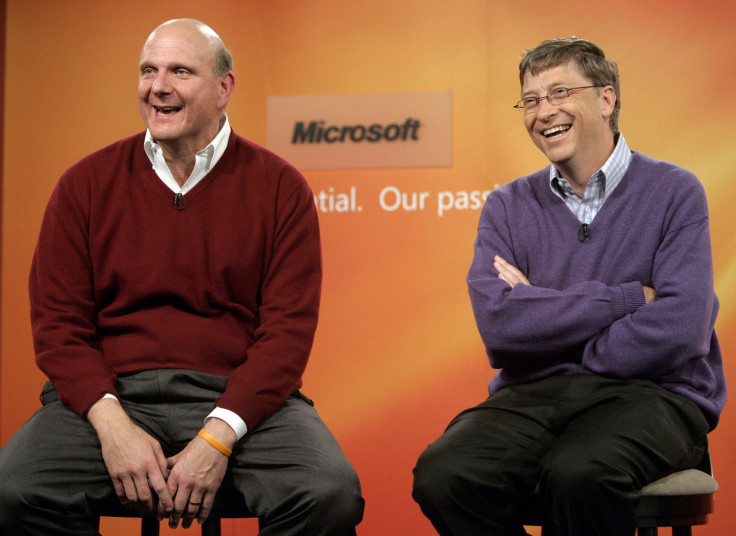Ballmer's Clippers Bid Another Sign Of Different Paths Taken By Microsoft Fraternity

The $2 billion that Steve Ballmer is offering to buy the Los Angeles Clippers is just the latest twist in the vastly different paths taken by the fraternity of tech titans who've retired from Microsoft over the last two decades.
Since transforming the computer software giant from a startup with fewer than 40 employees into a multinational behemoth with $20.4 billion in revenue, Bill Gates, Paul Allen and Ballmer have spent their wealth in a variety of ways, from funding malaria research and the search for extraterrestrial beings to buying yachts and basketball teams.
Gates, the world's richest man and biggest philanthropist, has had the greatest impact, using his foundation's $36 billion endowment to tackle disease and poverty in the developing world and to improve education in the U.S..
“Whether your chief resource is volunteer time or hard-earned dollars, for a relatively small investment, catalytic philanthropy can make a big impact. For me it’s proven the best job in the world, as thrilling and humbling as anything I’ve ever done,” Gates wrote in a 2012 Forbes article on his philanthropic work.
Gates’ other ventures include Corbis, a digital media company aiming to create one of the world’s most comprehensive digital archives of art and photography from public and private collections around the globe. Along with fellow billionaire Warren Buffet, Gates has persuaded more than 100 of the world’s wealthiest people to sign on to the Giving Pledge, a promise to donate at least half one's net worth to charity.
Ballmer, the former Microsoft CEO with an estimated worth of $20 billion, is known for his charisma. Ann Livermore, a former executive vice president at Hewlett-Packard, once described him as “the kind of businessman most companies either wish they had working for them or wish they didn’t have to deal with.” His farewell address to Microsoft employees was delivered with his trademark intensity, pumping his fists in the air, shedding tears as the popular 1987 song "(I've Had) The Time of My Life" played on the sound system. At one point he screamed, "You work for the greatest company in the world. Soak it in!"
Outside the office, Ballmer has directed a fair share of his earnings toward sports. The 58-year-old won the bid to buy the Clippers from co-owner Shelley Sterling in wake of a racism scandal involving her husband. Despite rumors of competition for the team from Oprah, Floyd Mayweather and Magic Johnson, Ballmer’s record bid was approved by Sterling late Thursday and the negotiated sale will now move to the league for approval.
Ballmer had vied for NBA teams in the past with no success. In 2008 he joined an investment group that would fund renovation costs to Seattle’s KeyArena in an effort to keep the Supersonics out west. Instead, the team moved to Oklahoma City. Four years later, Ballmer joined another Seattle investment group to help build a new sports arena in a (failed) attempt to purchase the Sacramento Kings.
While Ballmer does not have a high-profile name in the philanthropic world, his wife, Connie, does. She has been deeply involved in nonprofit work and helped found Partners for Our Children in 2007.
Like Ballmer, Microsoft co-founder Paul Allen, who resigned in 2000, has a soft spot for sports. He bought the Portland Trailblazers in 1988, becoming the youngest owner in major league sports at the time. In 1997, he purchased the NFL’s Seattle Seahawks, which under his ownership won the franchise’s first Super Bowl in 2013. Allen bought the team for $194 million and put $130 million toward a new stadium. The Seahawks are now worth $1 billion.
“It’s a whole different thing when you become an owner,” said Allen on his experience as a franchise owner. “You know the coaches and the players and you’re representing your city, too. For me, there’s an aspect of ownership that you need to think about it as a responsibility to the community and try to do the best by the community as you can, all while enjoying the process of what happens behind the scenes, with the draft and free agency.”
The 61-year-old college dropout has a diversified portfolio with investments in tech, media and energy stocks, and rising real estate values in his hometown of Seattle. One of his more high-profile ventures is called Stratolaunch, whose goal is to develop the world’s largest airplane designed to launch satellites from mid-air into low-earth orbit. A two-time cancer survivor, Allen has spent more than $1.5 billion in brain and artificial-intelligence research, science education and environmental preservation. He also gave $30 million in 2001 to fund an array of telescopes used by the SETI Institute to search for evidence of extraterrestrial life. And he was one of the top five tech donors in 2013, donating $206 million to the Paul G. Allen Family Foundation and to the Experience Music Project Museum in Seattle.
© Copyright IBTimes 2024. All rights reserved.






















